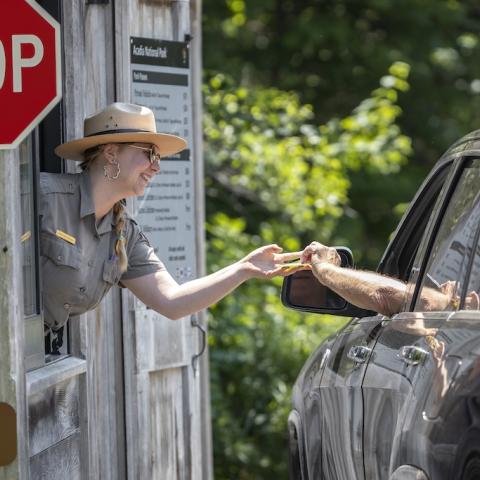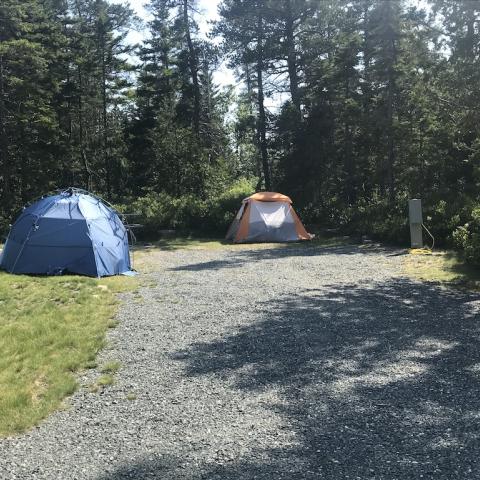When you're crossing the Colorado River in the middle of winter, wearing snowshoes, it's best not to have the ice give way and drop you into the river. Sheridan Steele can attest to that.
“It was like waist-deep," recalled Steele, who was Rocky Mountain National Park's chief of operations at the time, a job that easily could have been his last in the National Park Service. "And then there was this gap, say a foot or two, between the water surface and the ice. The water level, it fluctuates below the ice, and that made it a little more difficult to get out.
"The immediacy of the moment, you’re really focused on getting out of the predicament, and it wasn’t really until the next day that it kind of hit me that, 'Wow, that was really a close call.’ That could have been very serious had I gone under the ice, or downstream," Steele told me. "It probably would have been all over. But, I was fortunate enough, we had a park radio, and I could get somebody to come and get me. That was nice to get out of stiff, cold clothes.”
For 38 years Steele worked for the Park Service, serving as superintendent in six parks during a career that culiminated with a 12-year stint at Acadia National Park in Maine. He recounts the Colorado River incident, and many others, in a book of memories, From Bear Dens to the Oval Office, that offers an insider's view of life in the agency.
Most are heart-warming, self-effacing, and amusing short stories that allow you to jump back and forth through the book. But he also writes about park wildlife issues, search-and-rescue missions, and the challenges of wildfire. Others stories explore the mission of the National Park Service and illustrate the daily challenges its employees face.
Steele frequently applauds the rangers he worked with and volunteers, such as those in the Student Conservation Corps, while also offering insights to the political currents that swirl around the Park Service. Some of those challenges are local, such as relations with gateway towns always anxious for winter-bound parks to open as soon as possible in the spring.

Removing snow from Trail Ridge Road in Rocky Mountain National Park is always a slow process in spring/NPS file
"The target date was always Memorial Day weekend, and the town of Grand Lake depended on this to jumpstart its short tourist season. Residents of Grand Lake and Estes Park always complained that the road (Trail Ridge in Rocky Mountain National Park) was slow to open," writes Steele. "The problem was at the elevation of these towns, about 8,500 feet, the roads were free of snow much earlier than at 11,000 or 12,000 feet. Drifts could be fifteen to twenty feet high in places. To convince people of the work involved to open the road, we offered free bus tours to the work site on each side. Once shop owners appreciated the depth of the problem, they soon told others of the challenges the road crews faced, and we received fewer phone calls."
But there are sections of the book that illustrate the conflicts the Park Service can encounter, politically, when it comes to preserving landscapes and resources within the parks.
The former superintendent, now a member of the executive council for the Coalition to Protect America's National Parks, recounts a tough situation involving a 147-acre parcel of private land inside Black Canyon of the Gunnison National Park in Colorado. Steele, at the time the park's superintendent, tried to get the U.S. Justice Department to use the federal government's right of eminent domain to acquire the property. The gulf between the value the Park Service and the owner placed on the property stalled the process, and when George W. Bush became president "the eminent domain action was halted without progress or conclusion because of a difference in philosophy. Today, political considerations mean that the National Park Service must acquire land from willing sellers only," Steele points out.
At Acadia, he faced a somewhat similiar case of private property surrounded by the national park on three sides that ended with a more celebratory outcome. Through networking and working with individuals, organizations, and foundations fond of Acadia, Steele was able to engineer a deal that brought 3,200 acres on the Schoodic Peninsula into the park. The short story is the land was acquired for less than $15 million...the longer story of the process that was involved is worth reading in Steele's own words.
The former superintendent also takes some time in his book to highlight the ongoing, and ever-challenging, budgetary situation the Park Service faces when it comes to staffing the parks to provide for a great visitor experience while also protecting natural resources.
"Further budget reductions will likely mean curtailed visitor center hours with some facilities being closed altogether; park ranger-led programs will be dropped or dramatically reduced; emergency response time will increase; resource monitoring and restoration programs will be a distant memory; and restrooms will not be as clean," he writes near the end of the book. "In short, both the parks and the visitor experience will suffer as a result.
"Many parks will allow some permanent positions to remain unfilled (after a transfer or retirements) to fund the critical seasonal positions," he continued. "Of course, any vacant position means that other work is not being done."
During our phone conversation, Steele reiterated that concerning picture facing the National Park System.
"As the visitation climbed, our ability to put staff in the field and do all those other kinds of things was going down," he said, referring to his time at Acadia. "I remember the numbers, over a ten-year-period our visitation went up 55 percent, and our budget went down like 8 or 10 percent. So, it was becoming a serious problem. How do you continue to staff the park at an appropriate level and deal with the growing number of visitors?”
Still, he believes the workforce will figure out how best to manage things in these trying times.
"The National Park Service has a lot of really hardworking, dedicated employees," said Steele. "They’re always striving to serve the mission in the appropriate ways. I think by and large we’re doing well as an organization. I just hope it continues."
At Acadia, he said, the workforce and the outside supporting groups made the job the pinnacle of his career.
"It was the perfect situation. We had tremendous community support and visitor appreciation for what we did, and we had a friends group that probably was one of the top five in the U.S. in terms of effectiveness," he said. "We had interesting issues and we had a really good staff. A great staff.
“And it just made it, I say in the book, I loved going to work. I just really loved going to work. I actually regret that I retired.”
From Bearn Dens to the Oval Office can be found on Amazon. Proceeds to to the Coalition to Protect America's National Parks,





 Support Essential Coverage of Essential Places
Support Essential Coverage of Essential Places






